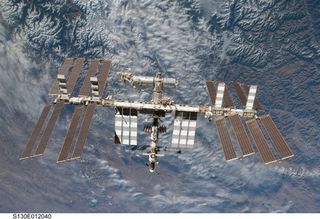How Would NASA & Russia Evacuate the International Space Station?

In the wake of a Russian rocket failure, NASA is considering evacuating the crew of the International Space Station later this year. The unprecedented move would mark the first time in more than 10 years that the orbiting outpost has gone unmanned.
The space station evacuation is one possibility following the failure of the unmanned Russian supply spacecraft just after its Aug. 24 launch — a surprise given the reliable track record of its workhorse Soyuz rocket. The vehicle’s Progress 44 cargo craft, and its 2.9 tons of supplies bound for the International Space Station, crashed in Siberia.
An investigation into the cause of the failure is under way, but until the issue is resolved NASA and its Russian partners are delaying upcoming launches to crews and cargo to the space station. The Soyuz rockets used to launch Progress vehicles are similar to ones used to launch crews into orbit, station managers said. [Photos: Russia's Lost Cargo Ship Progress 44]
So if a root cause isn't found quickly, they may have to ground manned Soyuz rockets for the time being, forcing the space agencies to leave the $100 billion orbiting laboratory unmanned for the first time since 2001.
"The focus of the entire program, and in particular our Russian colleagues, is to determine the cause of the anomaly and to resolve it and to get back to flying safely," said Mike Suffredini, NASA’s space station program manager, during a briefing today (Aug. 29). “We’ll focus on keeping the crews safe. Our next focus is to try to keep the ISS manned."
Only once before, after the 2003 space shuttle Columbia disaster, which destroyed that orbiter and its crew, did NASA consider evacuating the International Space Station — a process agency officials call "de-manning." In that case, though, managers decided to continue sending crews to the station on Soyuz rockets until the shuttle was ready to fly again.
The space station was designed to be able to operate autonomously, without crew onboard, if it needs to.
Get the Space.com Newsletter
Breaking space news, the latest updates on rocket launches, skywatching events and more!
"If we have to de-man ISS, we do certainly have a safe way to do that as well," Suffredini said. "We’ll try to prevent that if we can."
The largest risk of evacuating the station is the possibility that some major component could break, or a significant anomaly could occur, and no astronauts would be available on orbit to fix it.
"There is a greater risk of losing ISS when it's unmanned than if it were manned," Suffredini said. "That’s why we made our decision after the Columbia accident to keep it manned, because the risk is not insignificant."
To de-man the space station would require no extraordinary preparations on the part of the six spaceflyers currently living aboard the ISS.
Most of its essential systems can be commanded from the ground. The astronauts and cosmonauts would close many of the hatches between modules to keep the individual orbital rooms isolated, for further protection against a failure in one part. External locks and docking mechanisms can even be prepared so that unmanned ships like Progress can depart and arrive robotically and autonomously, in cooperation with ground support.
"We'd prefer not to operate in that condition without crew onboard for an extended period of time," Suffredini said. "But assuming the systems keep cooperating we can command the vehicle from the ground and keep it running indefinitely." [Photos: Building the International Space Station]
In addition to the increased risk, the largest loss would be the ability of the crew to conduct research onboard, which is the main purpose of the football-field sized laboratory. Certain autonomous experiments could keep running, but most of the science research on the station would have to be shut down and postponed until astronauts and cosmonauts returned, Suffredini said.
You can follow SPACE.com senior writer Clara Moskowitz on Twitter @ClaraMoskowitz. Follow SPACE.com for the latest in space science and exploration news on Twitter @Spacedotcom and on Facebook.
Join our Space Forums to keep talking space on the latest missions, night sky and more! And if you have a news tip, correction or comment, let us know at: community@space.com.

Clara Moskowitz is a science and space writer who joined the Space.com team in 2008 and served as Assistant Managing Editor from 2011 to 2013. Clara has a bachelor's degree in astronomy and physics from Wesleyan University, and a graduate certificate in science writing from the University of California, Santa Cruz. She covers everything from astronomy to human spaceflight and once aced a NASTAR suborbital spaceflight training program for space missions. Clara is currently Associate Editor of Scientific American. To see her latest project is, follow Clara on Twitter.
